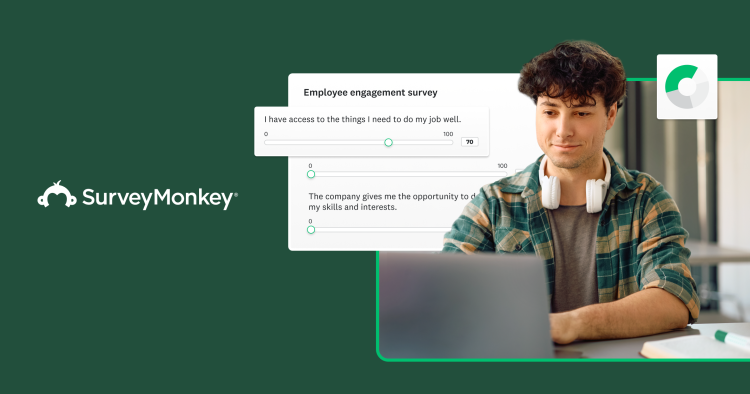Customer interaction reports: A guide to SurveyMonkey’s best customer centric program
At SurveyMonkey, it’s our mission to power the curious. We help people around the world answer their biggest questions with our products every day.
But it’s not just our customers that we help. We found out early that inquisitive, well-informed employees make better decisions and are far more effective at their jobs—especially when they’re well-informed about their customers.
That’s why we launched a series of customer centric initiatives aimed at getting employees to understand their customers on a deeper level—their pains, needs, and everyday interactions with our company.
Of all the strategies we’ve used to build a customer centric culture, no approach has been more important for our team than customer interaction reports (CIRs).
CIRs (which we affectionately pronounce as “cheers”) are simple: Any time an employee interacts with one of our more than 17 million active users, they conduct a simple interview—that can be as short as 5 minutes— to learn about how that customer is using any of the SurveyMonkey products. The questions can focus on the challenges our products help them solve, as well as the issues they’ve had with them. Then, the employee fills out a brief survey about their interaction, where their responses are automatically shared as an organized post in a public company channel.
It may not sound like much, but it’s fundamentally changed the way employees at SurveyMonkey think about their customers.
- It encourages employees to interact with the people they’re serving.
- It surfaces valuable insights and issues about our products.
- A constant stream of real-life customer stories both inspires and informs the entire company.
In this article, we’ll teach you everything you need to know about setting up your own customer interaction reports program. But to start, let’s review why customer interaction reports are so valuable.
Why CIRs are an essential customer centric strategy
Empathy. It’s what helps us bond with our friends, our family, and even our customers.
Employees who understand and care about the challenges that customers experience with their product/service are more likely to account for them in their day-to-day tasks: The engineer will identify—and fix—a product bug that’s been nagging customers; the finance manager will improve the payment collection process; the marketing writer will identify new content that can help improve product adoption, and so on.
Improvements in customer empathy also benefit employees and their organization:
- 76% of employees who report a high amount of customer empathy say their jobs are meaningful (versus 49% of employees who report low empathy).
- 82% of employees who believe their organization has a high level of customer empathy anticipate staying at their organization in 2 years time (versus 66% of employees who believe their organization has low customer empathy).
- 72% of employees who think about their customers once a week—or more often—find their jobs meaningful (versus 58% for those who don’t think about their customers at least once a week).
Customer interaction reports are an excellent way to build customer empathy. The personal interactions remind employees that their customers are real people and that the work they do really matters.
The best part about this kind of enthusiasm is that it’s contagious. Since customer interaction reports are automatically shared on a public, company-wide channel, everyone gets the opportunity to read stories that help them learn about their customers.
Our employees, across functions, have greatly benefited from participating in this customer centric approach. We’ll let a few members of our team explain how it’s helped them:
“Speaking directly to customers gives us a chance to understand which features are more valuable than others—and why. This information is super helpful when we’re deciding how to invest in our products."
Brad Belford
Product Manager
“The interactions give me a chance to learn about the different products SurveyMonkey offers and how each of them help our customers. Now I can better appreciate SurveyMonkey’s mission to ‘Power the curious.’”
Maggie Lin
Product Marketing Manager
“CIRs allow me to understand customer needs and issues more broadly, which gives me more confidence to pick out the most valuable content to share across our social platforms.”
Melissa Francois
Global Social Media Manager
How to set up your own customer interaction reports program
Any time you’re planning to run a company-wide initiative like customer interaction reports, it’s important to make sure you set up every detail before you launch.
If you don’t provide enough resources for employees to engage with customers and post their stories, your program will sputter before it catches on. But rest assured, once people get in the habit of conducting—and reading about—customer interactions, the program will take on a life of its own.
Don’t worry: We’ll tell you everything you need to orchestrate a strong launch, and run a successful program in 6 simple steps.
Step 1: Create the infrastructure using SurveyMonkey, Zapier, and Slack together.
Automatically delivering customer interaction reports to a public channel on Slack, where everyone at SurveyMonkey can read them, has been key. It greatly increases the number of people they’re exposed to and multiplies the value they provide for the company.
To make it super easy for employees to share their own customer interaction reports, we built a simple survey that captures all the key takeaways from their interaction.
Start your own program with our free survey template
Start collecting your own customer interaction reports by adopting the survey template we use here at SurveyMonkey.
You’ll notice that the survey template has both closed and open-ended questions. The open-ended questions are the core of the survey template. They’re the questions that make up your customer interaction reports, and they’re the ones that you’ll want to display publicly in your Slack channel, making a customer interaction report entry look something like this:
Reporter:
Julia Smart
Customer's company/organization:
Acme pet food
What does the customer use SurveyMonkey for?
"To measure the customer experience by emailing customers a short survey immediately after they make an online purchase."
What value does the customer get from using SurveyMonkey?
"They're able to pinpoint areas for improving their site and their products. Also, by tracking their responses over time, they're able to understand how the customer experience is evolving."
Anything else?
"Their Director of Customer Support, Bill Chan, mentioned that SurveyMonkey is super easy to use and did everything they needed it to do."
What is your impression of the customer's overall experience?
"Extremely positive"
While you might not want to publicly display the answers to the closed-ended questions in the survey, they can be useful for categorization once you’ve collected a critical mass of customer interaction reports. By using filter by question and answer, you’ll be able to quickly see all the customer interaction reports for a particular product or use case, or only see responses from a particular department or office.
To connect us with Slack using Zapier:
- Create a Zapier account.
- On the homepage, select the following options and then click “Use Zap:”

3. Connect your SurveyMonkey account.
4. Check off the box “New Response Notification with Answers.”
5. Select which survey you want the responses to come from.
6. Go on to the section on Slack. You’ll be asked how you want the responses delivered. Check off the option: “Send Channel Message.”
7. Connect your Slack account.
8. Pick the Slack channel you want the messages to go to (the channel should already exist).
9. Customize the message format by picking the questions you want to pull from and the order you want them to appear in.
10. Test it out! Once the integration works, you should be all set!
Step 2: Find customers for employees to interview.
As we mentioned before, it will take a bit of time to get your program rolling and have people creating their own customer interaction reports. In the meantime, it’s a good idea to find some customers for employees to interview to serve as an example of what customer interaction reports should look like (and why they’re so cool).
You can partner with your customer-facing colleagues to get a list of customers who are willing to speak to someone else on your team. Alternatively, you can host customer events that give employees a chance to meet customers over food and drinks.

Pro tip: To quickly grow your list of customers who are willing to be interviewed, add a question to your existing customer feedback survey that asks if they’d be willing to speak to someone else on your team.
Step 3: Provide resources to help employees conduct their own interactions.
Once an employee has a customer they can speak to, make sure they feel they have everything they need to conduct a professional, informative interview. Consider creating a mini-resource center that has:
- An email template for requesting the interview: Cold emailing people can be awkward. Employees will feel more confident (and procrastinate less) if you give them an example of how to reach out to a customer for an interview.
- Suggested interview questions: To ensure your team gets the most out of every interview, you can provide a list of questions they can ask. For example, you might tell them to ask about the interesting ways they’ve used your product, how other people in the company use it, and whether they’ve ever used a competitor’s product.
- Tips for conducting the interview: Remember that the people you want to conduct these interviews probably don’t interact with customers and may not know how to run a good interview. You don’t need to provide a script, but giving them guidelines for how to structure their conversation can help a lot.
We created a page on the company Wiki with all the resources employees need to get started, plus full explanations of the program, its guiding principles, and how incentives for it work.
Step 4: Offer fun incentives. Then offer some more!
Giving participants prizes, even non-monetary ones, can increase the awareness and participation in your CIRs.
At SurveyMonkey, we offer every employee who participates a cute sticker, which acts as a badge to show their participation in the program. The more customer interaction reports an employee files, the (arguably) cuter the sticker: One report earns them the sticker on the left, 3 gets them the one in the middle, and 10 lands them the one on the right. We’ve found that these badges, which most employees put on their laptops, add a fun, competitive element to the program and motivate employees to participate.

Additionally, our executives review the stories and pick two each month that stand out. The employees who get selected then present their stories to the entire organization during a company-wide all-hands meeting and also win a fancy pair of headphones!
Finally, our organization runs a drawing at the end of every year to award the grand prize: a free, weeklong trip to work at any of our offices, like Australia or Ireland!
The point is, you don’t need to break the bank to find an incentive that encourages employees to participate in your program. It’s possible to find fun, cheap incentives that help get people involved.
Step 5: Launch!
Now that you have the technical infrastructure for your reports set up, helpful resources for employees prepared, a few customer interaction reports in your pocket to get the ball rolling, and an incentive plan to get employees motivated, it’s time to launch!
It’s important to stick the landing here. We announced our program during one of our company-wide all-hands meetings to make sure everyone was aware of it. Immediately after the meeting, we sent an email to the entire company with all the information we’d prepared on the customer interaction reports program.
We announced ours with a company-wide goal of 100 customer interaction reports in a year (which we quickly surpassed). Having a goal that all the departments and managers felt accountable for really helped push employees to get out of their comfort zones and conduct some interviews.

Also, make sure to partner with your internal communications team to periodically remind employees about customer interactions in company emails and during employee-wide meetings. You never know when your team is paying attention, so the more places you find to talk about CIRs, the higher the chances they become aware of it and decide to get involved.
Step 6: Measure the impact your CIRs have over time
You can use the number of customer interaction reports people file as a directional metric for how successful your program has been, but ultimately you’ll need a better way to track your success. It’s a good idea to survey your employees to find out how CIRs are impacting their work and their perception of your organization. Our customer centricity survey can help you get started.
The survey gives you a baseline understanding of how employees feel about your customer culture, which you can use to benchmark the effect of CIRs over time. You can also tailor the survey to ask about CIRs directly.
Finally, as you begin to see the impact your program has on your employees and customers, try to sell it to leadership as being a worthy measure for meeting your organization’s overarching goals. Once leadership is bought in, you can get their support in promoting the program and even attach tangible goals to it.
For example, after we blew our goals for the program out of the water last year, and because of the benefits leadership believes they offer, we’re focusing on a much loftier goal this year: We’re gunning for every employee to submit at least one report!
Customer interaction reports are an invaluable customer centric approach for your team—but there’s a whole lot more you can do to help employees better understand your customers.
Learn about your other options by reading about the 6 most important customer centric initiatives we’re running. They might just inspire you to go beyond CIRs.


